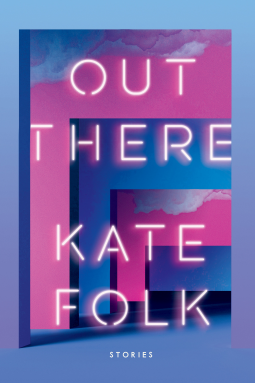REVIEW: A Collection of Savvy Stories that Take a Swipe at New Technology
/Out There by Kate Folk (Random House, 256 pgs)
By Zack Graham
The year is 2022, and the institution of dating has taken an interesting turn. Serendipitous romantic encounters with strangers leading to futures only fate could have preordained are antiquated relics of the past. The modus operandi now? Internet applications. The creation of profiles presenting one as perfect, lovable, and incredible—in other words, complete and total lies. Blind first dates on neutral ground. Variations of the same conversations over and over again. Instagram stalking. Ghosting. Blocking. And if you’re lucky? More dates. Netflix and chill. Beleaguered confessions of love. Meeting the parents 2x. The big move-in. All building to marriage proposals that double as optimized content, leading to weddings constructed by consultants who create punny hashtags and post-event videos reminiscent of car commercials.
Isn’t that utterly terrifying?
Kate Folk thinks so. And with her triumphant debut story collection Out There, she forces you to confront just how alien and repulsive modern romance can be.
The collection’s title story originally published by the New Yorker in 2020 (currently being adapted for Hulu TV) presents a version of San Francisco in which modelesque automatons called Blots woo women through dating apps to a cabin in Big Sur and steal all of their data for the Russians. In “Heart Seeks Brain”, people are physically attracted to each other’s internal organs (in this world, “classic vein” guys and “gastro” men are types). And in “The Turkey Rumble,” Ruben takes his new boyfriend Zach to his family’s Thanksgiving celebration, an annual tradition that involves all attendees inflicting physical pain upon one another in surprising and creative ways.
Though the genesis and dissolution of romantic relationships takes up the majority of Folk’s focus, her stories also eviscerate San Francisco tech culture and modern capitalism, decry objectification of women’s bodies, and wade into the hardships of failed marriage. Her stories are the best kind of bizarre, as acerbic as they are hilarious, disgusting, surreal and horrifying, warranting comparisons to the work of Ben Marcus, Diane Cook and Alexandra Kleeman.
The collection’s longer—and best—stories center around failed relationships. The most visually intense and harrowing story in the collection, “The Bone Yard”, takes place on a ward for people suffering a disease called Total Nocturnal Bone Loss (TNBL), which is as disgusting as it sounds.
“We watch her skeleton melt with alarming speed. Greg touches her upper arm and his glove comes away sticky with calcium sap, a by-product of bone dissolution. Her face sags into a leering putty mask. Her head drops on the wilting stem of her spine. I avert my eyes, feeling nauseous.”
The unnamed narrator of “The Bone Yard’ is in a relationship with Bradley, a classical musician who, like the narrator, is recovering from TNBL on the ward. When a new woman named Olivia arrives on the ward, and Bradley discovers she is also a musician, he quickly loses interest in the narrator in favor of a new song-fueled romance. Jealousy overtakes the narrator, and she cruelly sabotages Olivia’s recovery in retaliation for Bradley’s abandonment, a decision she deeply regrets, and which leads to deadly consequences.
“The Moist House” plays on similar themes. Karl is a disgraced accounting executive who lost his consulting job and his marriage due to an affair with the receptionist at his firm. Shunned from his house and living off credit, he agrees to move into a rent-free house that has a catch: the house requires constant moisturizing. Karl quickly realizes that he must spend an inordinate amount of time and money procuring and applying lotion to the house’s walls, else the walls begin to crack and chafe, symptoms which also effect Karl’s skin. This all-encompassing surrealist fusion soon becomes Karl’s saving grace. When his former mistresses arrives and confesses her love to him, Karl refuses to let her in, for “now, he had the house. On behalf of their bond, he renounced all sympathies that tied him to the outside world.” Karl’s symbiosis with the house is so strong that not even his mother or his ex-wife can uncouple it.
Stories centered around such allegories and metaphors can feel too heavy-handed and fall flat, but in Folk’s hands they sing, explorations of love and belonging that force us to reevaluate how these notions intersect with our own lives. Folk’s protagonists are lonely people seeking companionship in all the wrong places, wanting more than anything to find love and yet having utterly no idea how to go about doing so.
If Folk’s collection has a weakness, it is repetition. Some sections of the collection—particularly the sections containing the shorter stories and flash fictions—feel as though they are iterating on the same themes of romance and dating without saying anything new. But these sections fade from memory when stronger, longer stories come to the fore, and Folk’s mastery once again takes center stage.
But I see why Folk is so obsessed with the ways algorithms distort and warp perceptions and relationships. After all, the algorithms that determine who people meet, fuck, date, and marry are similar to the algorithms that paved the way for the election of Donald Trump in 2016. That is absolutely terrifying for the future of humanity.
By the time you finish reading Out There, you’ll have resolved to never swipe again.
Zack Graham’s criticism has appeared in Astra, The Nation, Rolling Stone, GQ, The Believer, Jewish Currents, and the Los Angeles Review of Books, among other publications.










